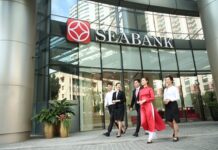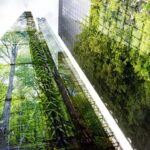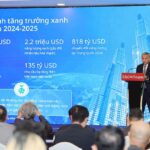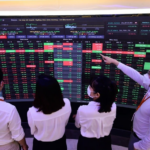Paradox in Industrial Parks: Green Demand and Grey Supply
Vietnamese businesses are under increasing pressure from the international market. The EU’s CBAM mechanism, which came into effect in October 2023 with a reporting phase and will impose carbon taxes from January 2026, directly impacts Vietnam’s four main export industries: steel, cement, fertilizer, and aluminum. According to the Transition Energy Agency, Vietnamese businesses in these sectors will have to provide detailed carbon emission data for their entire production chain, including the power system and inputs from the supply chain.
In addition, global brands such as Apple, Samsung, and Nike have made ESG compliance and Net Zero commitments prerequisites for collaboration. This has created a wave of “green” demands cascading from multinational corporations to local suppliers in Vietnam. However, the current supply of industrial real estate in Vietnam fails to meet this demand. While the industrial sector leads in green certification, with over 70% of projects LEED-certified in 2023, the vast majority of existing factories and warehouses were constructed following old standards.
These “grey” factories are typically characterized by outdated cooling and lighting systems that consume excessive energy, roofs unsuitable for solar panel installation, a lack of wastewater recycling systems, and ineffective waste management practices. This negatively impacts businesses’ ESG scores, limiting their access to green finance and reducing their competitive advantage in the international market.
According to a Cushman & Wakefield survey, “sustainability” is now among the top three priorities for businesses when choosing commercial real estate. More than 70% of companies are willing to pay an additional 7-10% in rent to occupy green-certified buildings to meet their emission reduction targets.
This contradiction is particularly evident when considering data from the UNDP and VCCI’s ESG Readiness Report, which shows that 76% of surveyed businesses lack a clear ESG governance structure, and 65% do not involve their executive boards in related matters. This reflects a significant gap between the awareness of ESG’s importance and the ability to implement it with the existing infrastructure.
Why Haven’t Factories Gone Green?
From the perspective of industrial real estate investors and developers, upgrading existing structures to meet green standards requires significant upfront investment. The cost of improving M&E systems, reinforcing roofs for solar panel installation, and retrofitting wastewater treatment systems can run into millions of dollars. Meanwhile, the ability to increase rents to offset these costs is limited due to the market’s high competitiveness.
Cushman & Wakefield’s logistics rental price statistics for the Asia-Pacific region in Q4 2024 show that Hanoi and Ho Chi Minh City have the lowest rents in the region, at around $5-6/m2/year, significantly lower than Singapore (~$15/m2) or Hong Kong (~$23/m2). With such low base rental rates, the gap between green and standard factories becomes a significant barrier to investing in upgrades.
|
Asia-Pacific Logistics Rental Prices, Q4 2024
Source: Cushman & Wakefield Research
|
Another significant obstacle is the lack of favorable financial models for retrofitting old buildings. According to a World Bank report on energy efficiency upgrades in emerging markets, retrofit programs often face financing challenges due to long payback periods and high technical risks. In Vietnam, green credit is primarily focused on new construction projects, with no specific support mechanisms for retrofitting existing buildings.
Meanwhile, tenant businesses face a dilemma. Renting green factories at higher costs can impact their price competitiveness, especially when production costs in Vietnam have already increased by 70% since 2019. On the other hand, continuing to rent “grey” factories exposes them to the risk of non-compliance with ESG requirements, high operating costs due to high energy consumption, and low ESG scores affecting their access to international capital.
According to the State Bank of Vietnam (SBV), the total outstanding green credit as of March 2025 exceeded VND 704,244 billion, accounting for 4.3% of the total outstanding credit in the economy. However, most of this capital is allocated to renewable energy projects and new green construction, with only about VND 25,000 billion (3.7% of green credit) dedicated to industrial green projects and green construction.
Policy gaps are also a crucial factor. While Vietnam has issued Decree 35/2022/ND-CP on the development of eco-industrial parks, there is no specific legal framework for retrofitting existing industrial parks. Moreover, according to GIZ Vietnam’s assessment of energy efficiency in the industrial sector, the ESCO (Energy Service Company) market in Vietnam is still nascent, with limited technical capabilities and infrastructure.
Finding Solutions from Advanced Models
Several successful models have been implemented worldwide to address the challenge of retrofitting industrial real estate to meet green standards. In Singapore, the Jurong Innovation District has become a paradigm, aiming for net-zero emissions for new buildings by 2045. This district requires all new buildings to achieve at least the Green Mark Platinum Super Low Energy certification from BCA and utilize a centralized cooling system and automated waste transport system.
|
Green Mark Platinum Super Low Energy certification by BCA: A green building rating system developed by the Building and Construction Authority (BCA) of Singapore. The Platinum Super Low Energy level is the highest grade, requiring buildings to achieve a minimum of 60% energy savings compared to the national standard, along with stringent criteria for resource efficiency, indoor environmental quality, and carbon emissions over the building’s lifecycle.
|
The Green Lease model, widely applied in developed markets, establishes a mechanism for sharing benefits and responsibilities between landlords and tenants in upgrading to green standards. According to the Better Buildings Partnership, Green Lease clauses not only stipulate cooperation obligations but also include energy data sharing, the installation of measurement systems, and commitments to using renewable energy.
In Thailand, the Map Ta Phut Industrial Estate is implementing a carbon sandbox program with support from the World Bank and IEAT. This program focuses on emissions reduction while creating carbon trading mechanisms, helping businesses save costs in the long run through reduced emissions.
Notably, the ESCO model in the Netherlands, through the Energiesprong program, has proven effective by using prefabricated components, allowing for retrofit completion within 7-10 days with a 70-80% energy consumption reduction rate. More than 10,000 buildings have been successfully retrofitted across Europe and North America.
In Vietnam, some pioneering models have emerged. DEEP C Industrial Zones in Hai Phong has implemented notable ESG initiatives, such as using 1,083 million cubic meters of dredged material as a substitute for traditional fill material in land leveling. This method saved the equivalent of 617,000 cubic meters of traditional fill material and preserved 54 plant species and over 18 animal and insect species.
VSIP III Binh Duong attracted a $1 billion investment from the Lego Group to build the world’s first carbon-neutral factory. This area boasts a 50-hectare solar farm, a closed wastewater treatment system, and a smart transportation network. According to the Global ESCO Market Report 2025, the global ESCO market has attracted approximately $38-39 billion in investment.
From Grey to Green Factories
Regarding policy solutions, Vietnam needs to establish a legal framework for Green Leases, similar to developed countries. This includes issuing specific criteria for green retrofit standards and financial incentives such as preferential interest rates and technical support from the state budget. According to the SBV’s Banking Sector Action Plan, there is a need to expand the green credit portfolio to include the upgrading of existing buildings, rather than focusing solely on new construction projects.
The Asian Development Bank (ADB) has committed to financing nearly $4 billion for 23 projects in Vietnam during 2024-2026, many of which focus on green economy and sustainable development. Efficient utilization of this capital for retrofit programs will create a strong ripple effect.
Solutions from investors should aim to develop flexible green upgrade packages, allowing tenants to choose investment levels that align with their financial capabilities and production plans. Combining public-private partnership (PPP) models with ESCO funds can help reduce the initial capital burden while ensuring service quality and long-term operational efficiency.
Additionally, guaranteed savings and shared savings contracts have proven effective in many markets, from the public to the private sector. In the context of Vietnam, for these models to be effective, clear incentives, a transparent legal framework, and uniformly applied technical standards are necessary.
On the tenant side, proactively negotiating “green” terms in factory lease agreements is essential, especially for items with quick payback periods and easy relocation, such as LED lighting, energy-saving equipment, or thermal management solutions. Investing in digital technology for energy management optimizes operating costs while significantly improving ESG scores, thereby enhancing access to international capital.
Financial institutions play a pivotal role in promoting the “greening” of existing factories. As suggested by EuroCham Vietnam’s Green Growth Committee, Vietnam should develop specialized green credit products for retrofit activities, accompanied by risk guarantee mechanisms and simplified approval procedures, to encourage implementation.
GGGI also emphasizes the importance of integrating digital technology in energy management and environmental monitoring. IoT systems, real-time data analytics, and automated ESG reporting will enable businesses to meet compliance requirements of international mechanisms like CBAM, while enhancing transparency and operational efficiency.
[1] https://nvsk.vnanet.vn/viet-nam-tro-thanh-diem-den-dau-tu-hap-dan-trong-qua-trinh-chuyen-doi-xanh-1-151386.vna
[2] https://www.cushmanwakefield.com/en/vietnam/news/2025/07/how-industrial-developers-are-ahead-of-the-green-transition
[3] https://en.vcci.com.vn/esg-funding-for-sustainable-growth
[4] https://www.cushmanwakefield.com/en/vietnam/news/2025/07/how-industrial-developers-are-ahead-of-the-green-transition
[5] https://www.worldbank.org/en/news/press-release/2025/06/18/a-roadmap-to-scale-up-energy-efficiency-for-jobs-affordable-and-reliable-energy
[6] https://www.cushmanwakefield.com/en/vietnam/news/2025/07/how-industrial-developers-are-ahead-of-the-green-transition
[7] https://sbv.gov.vn/vi/w/sbv626162
[8] https://www.esp.org.vn/news/giz-viet-nams-first-step-to-reduce-greenhouse-gas-emissions-in-workplace
[9] https://www.uradraftmasterplan.gov.sg/regional-plans/west/future-ready-sustainable-economic-hub
[10] https://www.burges-salmon.com/articles/102iyyu/green-leases-2024-edition
[11] https://solarquarter.com/2025/04/16/thailand-green-shift-map-ta-phut-carbon-sandbox-gains-momentum-with-world-bank-backing
[12] https://world-habitat.org/wp-content/uploads/2023/12/Project-Summary-Energiesprong-The-Netherlands.pdf
[13] https://deepc.vn/images/Report/DEEP_C_ESG_Report_2023.pdf
[14] https://en.vneconomy.vn/industrial-parks-in-green-transition.htm
[15] https://ktgindustrial.com/new/green-industrial-parks-in-vietnam
[16] https://c2e2.unepccc.org/wp-content/uploads/sites/3/2025/06/the-global-esco-market-trends-challenges-and-opportunities.pdf
[17] https://c2e2.unepccc.org/wp-content/uploads/sites/3/2025/05/global-esco-market-report-2025.pdf
[18] https://baolongan.vn/new-policy-promotes-green-banking-development-in-vietnam-a181476.html
[19] https://en.baochinhphu.vn/adb-to-finance-nearly-us4-bln-for-23-projects-in-viet-nam-in-2024-2026-111240123152649164.htm
[20] https://eurochamvn.org/vi/eurochams-impact-at-the-2024-vietnam-business
– 12:00 01/09/2025
“Unlocking Finance: Navigating the Challenges of Green Credit for Businesses”
The green finance market in Vietnam is hotter than ever, with a staggering 170% growth in the past year. Despite the increasing interest from businesses and financial institutions, the cost conundrum looms large, presenting a significant barrier. This challenge has prevented the path to accessing this sustainable source of capital from being truly open and inclusive.
Mr Lim Dyi Chang (UOB): Green Transformation Clears the Path for Vietnamese Businesses to Access Capital
The proactive shift towards a green economy is not just an environmental imperative but also a key strategy for Vietnamese businesses to enhance their competitive edge and tap into the billions of dollars of investment capital waiting on the sidelines.
“Fly Green with Vietjet: Reducing Your Carbon Footprint, One Flight at a Time.”
On August 22, 2025, a thought-provoking panel discussion, “Reducing Emissions, Cleaning the Air,” brought together experts, businesses, and regulators under one roof. Organized by Thanh Nien Newspaper, the event sparked insightful conversations on collaborative actions and green roadmaps for a sustainable future. The key message? It’s time to take charge and make a positive impact on the quality of life for all.














































